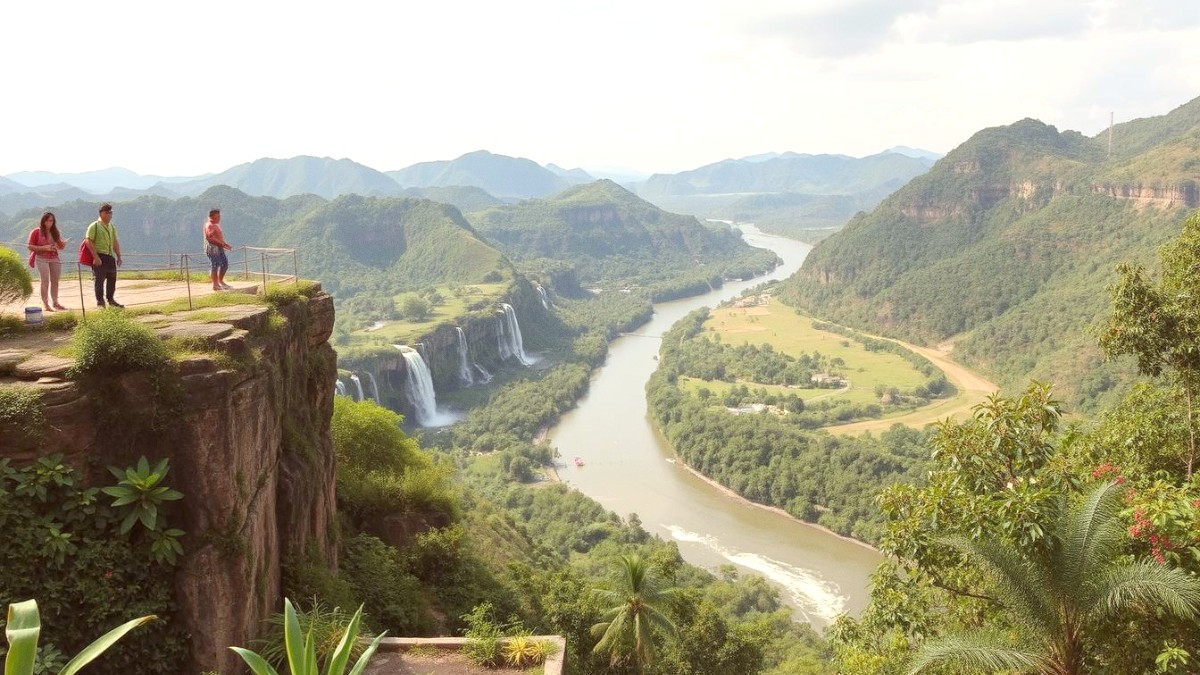
Southern Laos, Laos
This period is generally warm to hot with lower humidity. Pack lightweight, breathable fabrics like cotton or linen. Shorts, t-shirts, light dresses, and skirts are ideal for daily wear. These materials manage the heat. In evenings (October-February), temperatures drop slightly. A light long-sleeved shirt, a thin jacket, or a light cardigan provide comfort. During the hot dry season (March-April), loose-fitting, very light clothing in light colors reflects sunlight and promotes airflow. Clothing with UV protection for extended outdoor time is an option.
High humidity and frequent rain define the wet season (May-September). Prioritize quick-drying materials. Synthetic blends or specialized travel clothing that wicks moisture away are excellent choices. Quick-dry shorts, t-shirts, and light trousers are useful. A Lightweight, packable rain jacket or a Compact travel umbrella provide protection for sudden downpours. Both options keep you dry without adding significant bulk. Modest dress is appreciated. When visiting temples or sacred sites, cover your shoulders and knees. This applies to both men and women. Pack long pants or a long skirt, and a t-shirt or shirt with sleeves. A Lightweight scarf or sarong is a versatile item.
Required for city exploration, markets, and lighter treks. Closed-toe shoes are good for motorbike tours, for more protection than open sandals.
Useful for wet season, showers, hotel pools, or waterfalls. They dry quickly.
For extensive trekking or multi-day hikes, sturdy hiking shoes might offer ankle support and traction. For most waterfall visits, athletic shoes or robust walking sandals are sufficient.
Carry specific documents to ensure smooth travel. Protect both original and copy versions.
Laos uses Type A, B, C, E, and F outlets (230V at 50Hz). A Universal travel adapter with built-in USB ports is highly recommended. Check if your devices are dual voltage (100-240V). Most modern electronics are dual voltage. A High-capacity power bank is useful for keeping your devices charged. Power outages occur, notably in rural areas. Ensure your Smartphone is unlocked for a local SIM card. Unitel often gives the best coverage.
Pack your standard camera gear. For waterfalls or river activities, consider a Waterproof action camera. A Dry bag for camera gear is useful for boat trips. Download offline maps (Maps.me, Google Maps) and the Lao language pack for Google Translate. Banking apps help manage finances. Regularly back up photos and documents to cloud storage or a Portable external hard drive or USB flash drive.
Consider a VPN service like NordVPN or ExpressVPN for secure internet access, especially on public Wi-Fi.
For camera gear or electronics, B&H Photo presents options for pre-trip purchases.
For mobile data without physical SIMs, Airalo offers convenient eSIM packages for various destinations.
A well-stocked health kit manages minor ailments. Pack a Compact travel first aid kit. Include Band-aids, antiseptic wipes, sterile gauze, medical tape, pain relievers like Ibuprofen or paracetamol, and Anti-diarrhea medication (e.g., Imodium, Pepto-Bismol). Add antihistamines, Hydrocortisone cream, oral rehydration salts, and tweezers. Carry all prescription medications in their original packaging with a doctor's note, especially for controlled substances.
A strong Insect repellent containing DEET (30-50%) or Picaridin is important. Mosquitos carrying dengue fever are a concern. Apply regularly, especially at dawn and dusk. High SPF sunscreen, a broad-brimmed hat, and Sunglasses are important for sun protection. The tropical sun is intense. Consider a Personal water filter bottle or purification tablets for local water sources. Pack personal hygiene essentials you prefer, as specific brands are difficult to find locally.
A Small daypack (15-25L) is useful for carrying water, snacks, a camera, and a Light jacket. Bring Swimwear if you plan to swim at waterfalls.
A sturdy, comfortable backpack (20-30L) is useful for carrying clothes, toiletries, and other essentials for an overnight loop. Rent motorbikes locally; shops provide basic helmets. If you prefer higher safety standards, bring your own DOT-approved Motorcycle helmet.
Bicycles are available for rent locally, inexpensive and ideal for exploring Pakse city. No notably unique specialty items are required for typical Pakse experiences that you would need to bring from home.
For long bus journeys, a Travel neck pillow, Eye mask, and Earplugs significantly enhance comfort. A Padlock secures luggage or lockers. A Money belt or hidden pouch keeps cash and passport secure. RFID protection for credit cards is a good addition. High-quality sunscreen, specific Western toiletries, and certain prescription medications are best brought from home.
To reduce your environmental impact and save money, carry a Reusable water bottle, a Reusable shopping bag (for market visits), and a set of Reusable utensils. Many guesthouses accept water refills. The items listed under health and general packing for a tropical climate are useful. These include quick-dry clothing, strong insect repellent, and sun protection.
Reduce plastic bottle waste.
Support local economy and reduce carbon footprint.
Eco-friendly transport within the city.
Be aware of your impact.
Pack light. It makes traveling between destinations easier, especially on buses or when hiring smaller vehicles. Most guesthouses offer laundry services, or local laundromats are available.
Roll your clothes to save space and reduce wrinkles. Use packing cubes for organization.